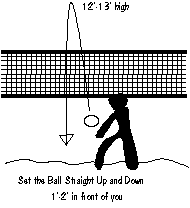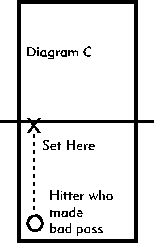How and Where To SetConsistency! Everything that you will read in these How To Articles has as it’s basis, consistency. Doing the same thing over, and over, and over, again, and again, the same way, with the same result is the single most important thing you can do on the beach. You don’t have to be bigger, stronger, or even better skilled than the other team, just more consistent and able to side-out when you receive serve, and you will win. Remember, they can’t score points if you side-out, and you can’t lose, if they can’t score points (even in a rally game). Where to pass the ball was covered in an earlier article. Now we have to get to the passed ball and set our partner so that they can hit the ball. Once you realize that you’re not going to pass the ball you should start to move into your setting position. You don’t want to get all the way up to the net, about halfway to the position that you expect the pass to go will do. This will allow you to recover if your partner doesn’t make a perfect pass (shanks) and at the same time you won’t have to rush to get to a good pass. Ideally, you will be one to three feet off the net and directly facing where you want the set to go. You must learn to bump set the ball consistently and accurately because your partner will not be able to give you a pass that you can handset every time. Additionally, when you bump set the ball no referee can ever call you for bad hands. The following applies to a good pass: You want to set the ball virtually straight up, so that if the ball were not to be hit it would fall one to two feet in front of you and one to two feet off the net. The ball should reach a height of 12’-13’ (that is 4’ to 5’ above a men’s net) and, if possible, you want the ball to have a slow forward rotation (toward the net).
The rotation will tend to make the ball stay in it’s trajectory even with the wind blowing, much the same as a pitcher’s fastball tends to fly straight. Don’t push the ball out to your partner at the sideline if you are in the middle of the court, let your partner come to you and hit the ball. If you follow this advice, there will never be a time when the hitter doesn’t know where the set is going to be. If your partner likes to hit from outside, have him pass the ball where he wants to hit from and you go there and set the same straight up set where he wants it. If you set the ball from the middle to the outside, you give the wind a much longer time to have an effect on the ball and any minor aiming mistake you make will be greatly exaggerated by the time the ball travels that far. For those same reasons, a bad pass makes everything that much more difficult. The following applies to a bad pass: First and foremost, do not compound the mistake of that bad pass by trying to make an extremely difficult (for you) set. Some players can set a ball from anywhere on or off the court and others have a hard time setting a good pass. You must determine which of those you are and set accordingly. If you fall into the hard time setting class just try to put the ball somewhere that your partner can play it over the net.
That usually means halfway between you and the net and halfway between where you and your partner are. (See Diagram B) This leaves plenty of room for error while still allowing your team to get the ball over the net. If you are more comfortable with your setting skill, then you really have several options. However, the safest thing to do is to always try to set halfway between you, your partner, and the net as shown in diagram B. First thing to consider when you are trying to set a bad pass is whether your team served or the other team served. If you served the ball, and you try to make a tough set and miss it, it’s only a side-out rather than giving up a point. At the same time though, you are also giving up the chance for a point and those chances can be hard to come by. On a pass that has been shanked and is well off the net (more than 15’ away) that you can still reach comfortably and you do decide to set the ball to the net, always make sure that you communicate your intention to your partner so that he isn’t waiting way off the net and has to rush to catch up with your set. Don’t try to keep this a secret from the other team. It is much more important that your teammate know the set is going to the net than it is to surprise the other team. You may surprize both the other team and your partner, resulting in the ball landing on your side of the net without your partner hitting it, if you try to be deceptive. So, be loud, when you tell your partner what you are doing. Now that you have decided to try and set your partner on the net how do we decide where the ball should go? First, aim the ball to the spot on the net directly in front of your partner.(See diagram C)
Make sure you don’t push the ball out past this point or onto your opponent’s side. Always keep in mind that you want the ball to stay on your side or you give the other team an easy block. You also want to make sure the hitter does not have to reach back and out to hit the ball. Second, it becomes very important that the ball be set high enough so that your partner will have enough time to react. As a general rule, set the ball so that at it’s peak it will be as high as you are off the net, within reason, of course. I notice that many players, when they make a bad pass, will whine about their bad play instead of staying prepared and helping their partner help them. Play now, whine after the ball hits the ground. Remember that!!! When you whine about how bad you are in the middle of the play, your partner tends to give up assuming that you have already given up. Don’t give up until the ball hits the ground! You know, some of these truisms really apply to all forms of volleyball, indoor 6’s to beach 2’s. So, if you are going to err on your set, err so that the ball is farther off the net rather than over and more inside rather than outside. All of these things, of course, depend on whether you are playing with a right handed or left handed player with some adjustments required for the differences, but, for the most part, everything applies nearly equally. For a pass that has been shanked either into the net, or extremely close to the net, and you think you can reasonably expect to set it, the rules are vastly different. Do you and your partner a big favor by playing the ball as close to the ground as possible. It will give you a little more time to react and that little bit of time might be all you need to turn a disaster into a great play. The smartest play you can make is to set the ball straight up and down and slightly towards the net (even if the ball is coming out of the net try to set it closer) and then let your partner deal with it like a middle hitter would have to deal with it indoors. Why closer? Your partner will be able to deal much more easily with a ball that is too close to the net compared to one that is over his head and behind him and with passes that are coming out of the net the most common error results in the ball going towards the back of your court when you try to set it. By trying to set it closer, you stand a better chance of a mistake going straight up and down or forward which still leaves your partner with a hittable ball. In most cases, if the ball goes behind the hitter, he will not be able to stop his approach and go back to get it, resulting in the ball landing on your side giving the other team either a point or sideout. As you will remember, giving up points is bad in volleyball. If you can’t set the ball, for whatever reason, just try to get the ball to go right to where your partner is and let him get it over the net. Of course, the best answer for all of these situations is to pass better to start with, so practice your passing more than your hitting. One of the fundamental rules of beach volleyball is: If you can’t pass, You can’t win! |


